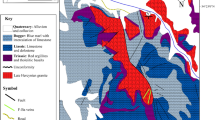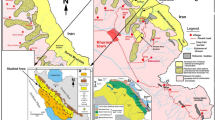Abstract
Fluorite mineralization occurs in Middle Triassic dolomite of the Shotori formation in the Kamar-Mehdi region, southwest of Tabas, Iran. Ore deposits consist of fluorite, barite, galena, calcite, and quartz. The accompanying minerals are iron and manganese oxides, pyrite and malachite. Alteration of wall-rocks include silicification and dolomitization. The character of the mineralization and the relationship between ore-host rock indicates that fluorite mineralization is epigenetic. Analysis of rare earth elements (REE) in the fluorite samples indicates low values in ranges between 3.01 and 6.79 ppm for early fluorites and 25.86 and 17.46 ppm for late fluorites. These concentrations indicate that fluorites have originated from a sedimentary environment. Also, Tb/Ca versus Tb/La suggests a hydrothermal-sedimentary origin for the Kamar-Mehdi fluorites. La/Yb and chondrite-normalized REE patterns reveal that the early fluorites are enriched in LREE (light rare earth elements) and the late fluorites are enriched in HREE (heavy rare earth elements). The late fluorites have resulted from the mobilization and recrystallization of the early fluorites. Ce/Ce* ratios show negative Ce anomalies for all fluorites, indicating a high oxygen fugacity in hydrothermal fluids. Eu/Eu* ratios show negative Eu anomalies for the early fluorites and positive Eu anomalies for the late fluorites, indicating that the early fluorites have formed above 200 °C and the late ones below 200 °C in temperature. La/Yb ratios and chondrite-normalized REE patterns are similar for fluorites and the host rocks, indicating that these elements have originated from the host rocks. There is an overlap between the δ13C composition of calcite associated with the fluorite (−0.9 ‰, −0.10 ‰) and that of carbonate sediments of the contemporaneous Triassic sea. This indicates the participation of Triassic seawater in the ore-forming fluid. The δ18O composition of the calcites (−10.94 ‰, −10.03 ‰) is similar to or a little lower than Triassic seawater. This difference is most likely due to the increase in the temperature of the hydrothermal fluids. The average δ34S values are −5.9 ‰ for galena and +20.8 ‰ for barite samples. These values show that seawater sulfate is the most probable source of sulfur. Reduced sulfur is most likely to be provided via the thermochemical reduction of sulfate. The existing data (such as tectonic setting, host rock composition, REE geochemistry, and oxygen, carbon, and sulfur isotopic compositions) indicate a sedimentary-hydrothermal origin for Kamar-Mehdi fluorite deposit.





Similar content being viewed by others
References
Bau M, Möller P (1991) REE systematics as source of information on minerogenesis. In: Pagel M, Leroy JL (eds) Source, transport and deposition of metals. Balkema, Rotterdam, pp 17–20
Bau M, Möller P (1992) Rare earth element fractionation in metamorphogenic hydrothermal calcite, magnesite and siderite. Mineral Petrol 45:231–246
Bau M, Romer RL, Lüders V, Dulski P (2003) Tracing element sources of hydrothermal mineral deposits: REE and Y distribution and S–Nd–Pb isotopes in fluorite from MVT deposits in the Pennine Orefield, England. Mineral Deposita 38:992–1008
Boynton WV (1984) Geochemistry of the rare earth elements: meteorite studies. In: Henderson P (ed) REE geochemistry. Elsevier, Amsterdam, pp 63–114
Castorina F, Masi U, Padalino G, Palomba M (2008) Trace-element and Sr–Nd isotopic evidence for the origin of the Sardinian fluorite mineralization (Italy). Appl Geochem 23:2906–2921
Chesley TJ, Halliday AN, Kesler TK, Spry PG (1994) Direct dating of Mississippi Valley-type mineralization: use of Sm–Nd in fluorite. Econ Geol 89:1192–1199
Claypool GE, Holster WT, Kaplan IR, Sakai H, Zak I (1980) The age curves of sulphur and oxygen and their mutual interpretation. Chem Geol 28:199–260
Constantopoulos J (1988) Fluid inclusions and rare earth element geochemistry of fluorite from south-central Idaho. Econ Geol 83:626–636
Dill HG, Hansen BT, Weber B (2011) REE contents, REE minerals and Sm/Nd isotopes of granite- and unconformity-related fluorite mineralization at the western edge of the Bohemian Massif: with special reference to the Naddburg-Wölsendorf District, SE Germany. Ore Geol Rev 40:132–148
Ekambaram V, Brookins DG, Rosenburg PE, Emanuel KM (1986) REE geochemistry of fluorite–carbonate deposits in Western Montana, USA. Chem Geol 54:319–331
Gagnon JE, Samson IM, Fryer BJ, Williams-Jones AE (2003) Compositional heterogeneity in fluorite and the genesis of fluorite deposits: insights from LAICP- MS analysis. Can Mineral 41:365–382
Ghazban F, McNutt RH, Schwarcz HP (1994) Genesis of sedimenthosted Zn–Pb–Ba deposits in the Irankuh district, Esfahan area, west-central Iran. Econ Geol 89:1262–1278
Ghorbani M (2007) Economic geology of mineral and natural resources of Iran. Arian Zamin. 492 p (in Persian)
Haas JR, Shock EL, Sassani D (1995) Rare earth in hydrothermal systems: estimates of standard partial molal thermodynamic of aqueous complexes of rare earth elements at high pressures and temperatures. Geochim Cosmochim Acta 21:4329–4350
Henderson P (1984) Rare earth elements geochemistry. In: Henderson P (ed) Developments in geochemistry, vol 2. Elsevier, Amsterdam, p 510
Hill GT, Andrew RC, Philip RK (2000) Geochemistry of southwestern New Mexico fluorite occurrences: implications for precious metals exploration in fluoritebearing systems. J Geochem Explor 68:1–20
Hoefs J (2009) Stable isotope geochemistry, 6th edn. Springer, Berlin, p 285
Jørgensen BB, Isaksen MF, Jannasch HW (1992) Bacterial sulfate reduction above 100 °C in deep-sea hydrothermal vent sediments. Science 258(5089):1756–1757
Karimzadeh F, Adabi MH (2008) Description of different kinds of dolomites in Shotori Formation (Kouhbanan area) based on petrographic and geochemical studies with a reference to the role of shales in the Sorkh Shale formation as a major source of Mg. Iran J Geosci 69:110–129
Khorshidi E (2015) Geochemistry and genesis of Kamar-Mehdi fluorite deposit, southwest of Tabas. PhD thesis of economic geology. Shiraz University. 220p (in Persian)
Korte C, Kozur HW, Veizer J (2005) δ 13C and δ 18O values of Triassic brachiopods and carbonate rocks as proxies for coeval seawater and palaeotemperature. Palaeogeogr Palaeoclimatol Palaeoecol 226:287–306
Machel HG (2001) Bacterial and thermochemical sulfate reduction in diagenetic settings—old and new insights. Sediment Geol 140:143–175
Maynard JB (1983) Geochemistry of sedimentary ore deposits. Springer, New York, p 305
Michard A (1989) Rare earth element systematics in hydrothermal fluids. Geochim Cosmochim Acta 53:745–750
Möller P, Morteani G (1983) On the chemical fractionation of REE during the formation of Ca-minerals and its application to problems of the genesis of ore deposits. In: Augustithis, S. (Ed.), The significance of trace elements in solving petrogenetic problems. 747–791. Athens
Möller P, Parekh PP, Schneider HJ (1976) The application of Tb/Ca–Tb/La abundance ratios to problems of fluorspar genesis. Mineral Deposita 11:111–116
Moore F, Sadeghi M, Jami M (1998) Physico-chemical characteristics of mineralizing fluids at the Kamar–Mehdi mine, Tabas region. Iran J Sci Technol 9:245–253 (in Persian)
Mourad Mahdy N, Hany Shalaby M, Mohamed Helmy H, Farage Osman A, El Sawey H, Korany Abu Zeid E (2014) Trace and REE element geochemistry of fluorite and its relation to uranium mineralizations, Gabal Gattar Area, Northern Eastern Desert, Egypt. Arab J Geosci 7:2573–2589
Ohmoto H, Goldhaber MB (1997) Sulphur and carbon isotopes. In: Barnes HL (ed.), Geochemistry of hydrothermal ore deposits, 3rd edition. Wiley and Sons, 517–611
Ohmoto H, Kaiser CJ, Geer KA (1990) Systematics of sulphur isotopes in recent marine sediments and ancient sediment-hosted base metal deposits. In: Herbert HK, Ho S E (Eds.), Proceeding of the conference on Stable Isotopes and Fluid Processes in Mineralisation, University of Western Australia 23: 70–120
Palmer DAS, Williams-Jones AE (1996) Genesis of the carbonatitehosted fluorite deposit at Amba Dongar, India: evidence from fluid inclusions, stable isotopes and whole rock-mineral geochemistry. Econ Geol 91:934–950
Parekh PP, Möller P, Dulski P (1977) Distribution of trace elements between carbonate and non-carbonate phases of limestone. Earth Planet Sci Lett 34:39–50
Pirouzi M, Ghaderi M, Rashidnejad-Omran N, Rastad E (2009) New evidences on mineralization, diagenesis and fluid inclusions at Kamar-Mehdi stratabound fluorite deposit, southwest Tabas. Iran J Crystallogr Mineral 1:83–94 (in Persian)
Ronchi LH, Tauray JC, Michard A, Dardenne MA (1993) The Ribeira fluorite district, Southern Brazil: geological and geochemical (REE, Sm–Nd isotopes) characteristics. Mineral Deposita 28:240–252
Sallet R, Moritz R, Fontignie D (2005) The use of vein fluorite as probe for paleofluid REE and Sr–Nd isotope geochemistry: the Santa Catarina Fluorite District, Southern Brazil. Chem Geol 223:227–248
Sánchez V, Cardellach E, Corbella M, Vindel E, Martín-Crespo T, Boyce AJ (2010) Variability in fluid sources in the fluorite deposits from Asturias (N Spain): further evidences from REE, radiogenic (Sr, Sm, Nd) and stable (S, C, O) isotope data. Ore Geol Rev 37:87–100
Sasmaz A, Yavuz F (2007) REE geochemistry and fluid-inclusion studies of fluorite deposits from the Yaylagozu area (Yildizeli–Sivas) in Central Turkey. Neues Jb Mineral 183:215–226
Sasmaz A, Yavuz F, Sagiroglu A, Akgul B (2005) Geochemical patterns of the Akdagmadeni (Yozgat, Central Turkey) fluorite deposits and implications. J Asian Earth Sci 24:469–479
Seal RR II (2006) Sulfur isotope geochemistry of sulfide minerals. Rev Mineral Geochem 61:633–677
Senowbari-Daryan B (2003) Micropaleontology of limestone beds within the Shotori dolomite (Triassic) of Kuh-e Nayband, Tabas area, east central Iran. Facies 48:115–126
Strong DF, Fryer BJ, Kerrich R (1984) Genesis of the St Lawrence fluorspar deposit as indicated by fluid inclusion, rare earth element, and isotopic data. Econ Geol 79:1142–1158
USGS (2001) Fluorspar. U.S. geological survey minerals yearbook-2000
Veizer J, Ala D, Azmy K, Bruckschen P, Buhl D, Bruhn F, Carden AF, Diener A, Ebneth S, Godderis Y, Jasper T, Korte C, Pawellek F, Podlaha OG, Strauss H (1999) 87Sr/86Sr, δ13C and δ18O evolution of phanerozoic seawater. Chem Geol 161:59–88
Williams-Jones AE, Samson IM, Olivo GR (2000) The genesis of hydrothermal fluorite-REE deposits in the Gallinas Mountains, New Mexico. Econ Geol 95:327–342
Wood SA (1990a) The aqueous geochemistry of the rare earth elements and yttrium. Review of available low temperature data for inorganic complexes and the inorganic REE speciation of natural waters. Chem Geol 82:159–186
Wood SA (1990b) The aqueous geochemistry of the rare earth elements and yttrium. Theoretical predictions of speciations in hydrothermal solutions to 350 °C at saturation water vapor pressure. Chem Geol 88:99–125
Xiang S, Jun D, Ligiang Y, Qingfei W, Zirong Y, Qingjie G, Changming W (2010) REE and Sr–Nd isotope geochemistry for Yixian fluorite deposit, Western Liaoning Province, China, and its geological implications. J Earth Sci 21:227–235
Author information
Authors and Affiliations
Corresponding author
Rights and permissions
About this article
Cite this article
Khorshidi, E., Abadi, B.E.A. REE and stable isotope (C, O, S) geochemistry of fluorite from the Kamar-Mehdi deposit, southwest of Tabas, Iran. Arab J Geosci 9, 123 (2016). https://doi.org/10.1007/s12517-015-2160-5
Received:
Accepted:
Published:
DOI: https://doi.org/10.1007/s12517-015-2160-5




